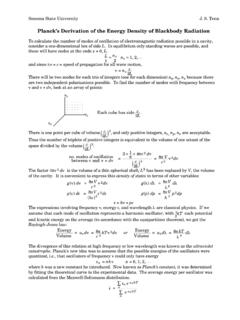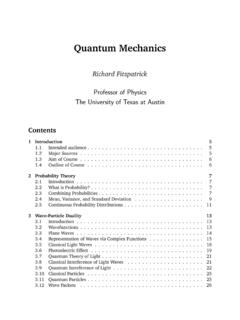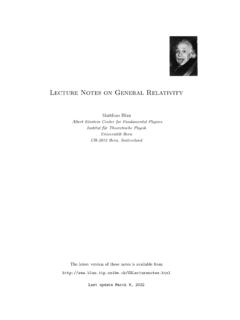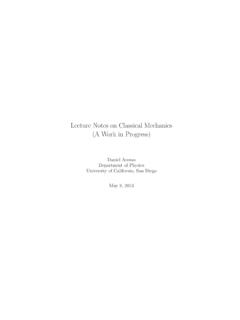Transcription of A Concise Introduction to Astrophysics
1 A Concise Introduction to Astrophysics Lecture Notes for FY2450 M. Kachelrie M. Kachelrie Institutt for fysikkNTNU, TrondheimNorwayemail: M. Kachelrie 2008, minor corrections Stellar astrophysics101 Continuous radiation from Brightness of stars .. Color of stars .. Black-body radiation .. Kirchhoff-Planck distribution .. Wien s displacement law .. Stefan-Boltzmann law .. Spectral energy density of a photon gas .. Stellar distances .. Stellar luminosity and absolute magnitude scale .. 182 Spectral lines and their Bohr-Sommerfeld model for hydrogen-like atoms.
2 Formation of spectral lines .. Hertzsprung-Russel diagram .. 233 Telescopes and other Optical telescopes .. Characteristics of telescopes .. Problems and limitations .. Other wave-length ranges .. Going beyond electromagnetic radiation .. Neutrinos .. Gravitational waves ..314 Basic ideas of special Time dilation a Gedankenexperiment .. Lorentz transformations and four-vectors .. Galilean transformations .. Lorentz transformations .. Energy and momentum .. Doppler effect.
3 345 Binary stars and stellar Kepler s laws .. Kepler s second law: The area law .. Kepler s first law .. Kepler s third law .. Determining stellar masses .. Mass-luminosity relation .. Stellar radii .. 426 Stellar atmospheres and radiation The Sun as typical star .. Radiation transport .. Diffusion and random walks .. Photo-, chromosphere and corona .. 467 Main sequence stars and their Equations of stellar structure .. Mass continuity and hydrostatic equilibrium .. Gas and radiation pressure.
4 Virial theorem .. Stability of stars .. Energy transport .. Thermal equilibrium and energy conservation .. Eddington luminosity and convective instability .. Eddington or standard model .. Heuristic derivation ofL M3.. Analytical derivation ofL M3 .. Lifetime on the Main-Sequence .. Stability of stars .. Variable stars period-luminosity relation of Cepheids.. Exercises .. 588 Nuclear processes in Possible energy sources of stars .. Gravitational energy .. Chemical reactions.
5 Nuclear fusion .. Excursion: Fundamental interactions .. Thermonuclear reactions and the Gamov peak .. Main nuclear burning reactions .. Hydrogen burning: pp-chains and CNO-cycle .. Later phases .. Standard solar model and helioseismology .. Solar neutrinos .. Solar neutrino problem and neutrino oscillations .. 689 End points of stellar Observations of Sirius B .. Pressure of a degenerate fermion gas .. White dwarfs and Chandrasekhar limit .. Supernovae .. Pulsars .. 7510 Black Basic properties of gravitation.
6 Schwarzschild metric .. Heuristic derivation .. Interpretation and consequences .. Gravitational radiation from pulsars .. Thermodynamics and evaporation of black holes .. 83II Galaxies8611 Interstellar medium and star Interstellar dust .. Interstellar gas .. Star formation .. Jeans length and mass .. Protostars .. 9112 Cluster of Overview .. Evolution of a globular cluster .. Virial mass .. Hertzsprung-Russell diagrams for clusters .. 9813 Milky Way .. Rotation curve of the Milkyway.
7 Black hole at the Galactic center .. Normal and active galaxies .. Normal Galaxies .. Hubble sequence .. Dark matter in galaxies .. Galactic evolution .. Active Galaxies and non-thermal radiation .. Non-thermal radiation .. Radio galaxies .. Other AGN types and unified picture .. 110 III Cosmology11314 Overview: Universe on large Problems of a static, Newtonian Universe .. Einstein s cosmological principle .. Expansion of the Universe: Hubble s law .. Cosmic distance ladder .. 1166 Contents15 Cosmological models for an homogeneous, isotropic Friedmann-Robertson-Walker metric for an homogeneous,isotropic universe.
8 Friedmann equation from Newton s and Hubble s laws .. Friedmann equation .. Local energy conservation and acceleration equation .. Scale-dependence of different energy forms .. Cosmological models with one energy component .. Determining and the curvatureR0from m,0,H0, q0.. The CDM model .. 12816 Early Thermal history of the Universe - Time-line of importantdates .. Big Bang Nucleosynthesis .. Structure formation .. Cosmic microwave background .. Inflation ..137A Some Mathematical formulae .. Some formulae from cosmology.
9 139B Units and useful SI versus cgs units .. Natural units .. Physical constants and measurements .. Astronomical constants and measurements .. Other useful quantities .. Abbreviations: .. Properties of main-sequence stars .. 1427 Astrophysics some introductory remarks Astronomy is with mathematics one of the oldest branches of science. It has served asbasis for calendars, navigation, has been an important input for religions and was for along time intertwined with astrology. Some of the most important steps in modern astronomy were: Galileo performed 1609 the first astronomical studies usinga telescope.
10 He discov-ered among others four Saturn moons and sun spots. Kepler (1571-1630) developed his three laws of planetary motions, based on obser-vations of Tycho Brahe. Newton established 1687 his laws of motion and gravitation. The measurement of the distance to Venus 1761 and 1769 duringits transits ofthe Sun with the help of the first global measurement campaignand to the neareststars 1838 by Bessel using trigonometric parallaxes established the first rungs inthe cosmic distance ladder. Fraunhofer discovered around 570 spectral lines in the solar light in 1814 andcatalogued them.










